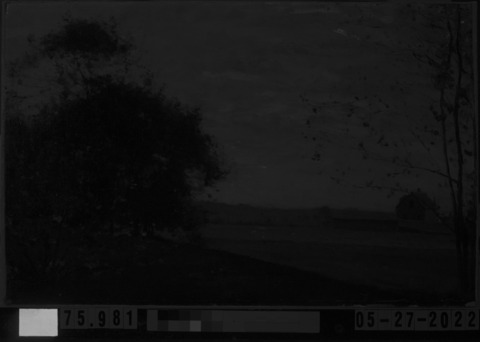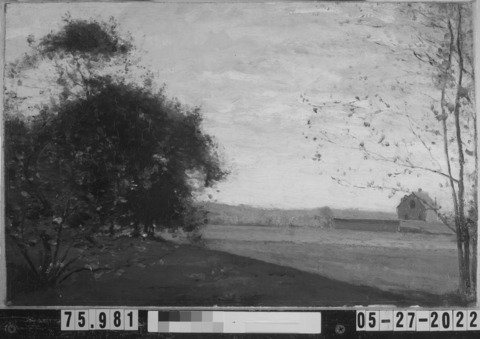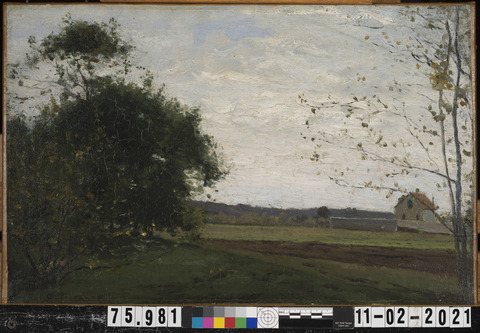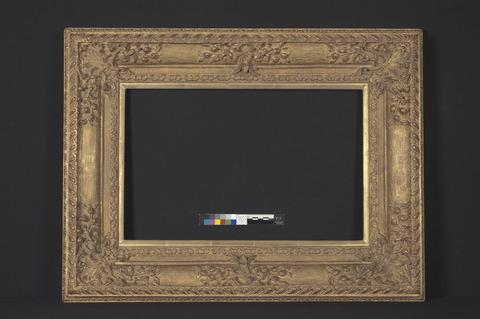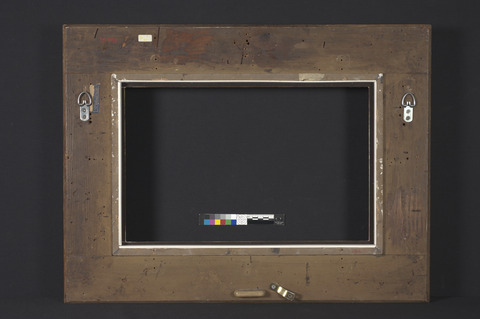OVERVIEW
Identification number: 75.981
Artist: Camille Pissarro
Title: Landscape
Materials: Oil on canvas
Date of creation: About 1864
Dimensions: 28.6 × 44 cm
Conservator/examiner: Alex Chipkin with contributions from Laura Mosteller
Examination completed: 2022
Distinguishing Marks
Front:
On the bottom left-hand corner, the artist has signed the work “C. Pissarro” in brown paint. No date is present.
Back:
Various numbers are written in graphite and colored pencil on the paper tape that covers the stretcher bars (fig. 1). There is a paper label in the center of the top horizontal member and remnants of two other paper labels that have been removed. The painting has been lined; therefore, no supplier’s marks can be seen from the back. It could not be determined whether the stretcher is original to the painting since the painting had been removed from its stretcher to be lined and paper tape covers the majority of the stretcher bars.

Historical Context
Landscape is the earliest painting by Camille Pissarro in the IMA’s collection, painted in about 1864 (fig. 2).1 Ten years earlier, Camille Pissarro moved to Paris from St. Thomas in the Danish West Indies where he was born. This scene was most probably painted outside of the city, possibly in Pontoise, or Louveciennes.
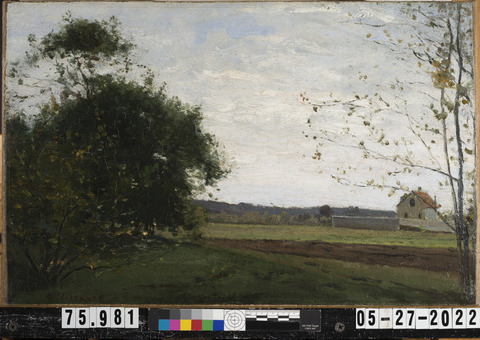
In this painting, Camille depicts a rural landscape in late fall or early spring. The landscape is evenly lit with the sun diffused by the cloudy sky. On the left-hand side there are two trees, lush with deep green leaves. On the right-hand side is a spindly tree, its branches mostly bare, the leaves just hanging on, blowing in the wind. To the left of the tree is a small farmhouse behind a slate-blue enclosure. Behind the house, a row of trees and blue hills stretch along the length of the horizon line. In the middle distance is a dirt road that leads the viewer’s eye back to the center of the painting.
This painting exemplifies the artist’s style at the beginning of his career: Impressionism was not yet in full swing, but artists of the Barbizon school like Jean-Baptiste-Camille Corot and Charles-François Daubigny were beginning to reject the authority of the Salon and work outside of it.2 Camille studied under Corot, and much of his early work shows that influence. The earth tones and blacks used in this painting are consistent with those of the Barbizon school.3 These are colors that, for the most part, would leave the palette of many Impressionist artists later in the century. But newly produced pigments were also starting to creep onto artist’s palettes at this time. One new pigment seen in this painting is cobalt blue, which was developed in 1804 by French chemist Louis Jacques Thénard.4 This bright blue pigment can be seen in the top center of the painting, used for the patch of blue sky peeking out between the parting clouds.
Summary of Treatment History
According to the IMA’s 1976 conservation report, Landscape came into the collection lined with an aqueous adhesive and bearing a natural resin varnish. Following a conservation assessment, the natural resin varnish was removed. The painting was then coated with two layers of synthetic varnish: the first was a layer of B67,5 and the second was a layer of B72.6 Inpainting was undertaken using a mixture of B67 and B72.7
In 1982, the painting’s condition was assessed in preparation for loan. Paintings conservator David Miller determined the work to be structurally sound and satisfactory to travel. In this report, he remarked that the varnish was moderately yellowed. He also noted a stress crack running across the upper-right quadrant, flaking on the upper-right corner at the margin, losses on the perimeter, and an accretion in the upper third of the sky. 8
In 2004, the painting was assessed before travel again by David Miller. He noted the painting was structurally stable and the canvas in good plane. He observed residues of dirt and old vanish in the interstices and small losses that were never inpainted. He described the “wide traction crackle” in the trees on the left “due to the artist’s technique and ageing” but concluded they were stable and of no concern. He wrote, “The appearance of the picture is satisfactory but could be made to look a little better if time permits."9
In 2021, the condition of the painting was again assessed by Alex Chipkin, Kress Fellow in Paintings Conservation, in preparation for the LUME Indianapolis: Monet and Friends Alive exhibition. Paper tape was noted as having been adhered to all four sides of the paining, overlapping onto the paint surface on the front. The varnish had become dull, and elements of the foreground, including the signature, were no longer legible due to the effects of imbibed dirt and the aged varnish that had become more matte over time. Discolored varnish and dirt were most apparent in the interstices of the lighter passages in the sky, which compromised the depth of the painting. Remnants of yellowed varnish were also visible on the borders of the painting, about ~0.5 cm from the turnover edge (figs. 3, 4). This points to the possibility that the painting was cleaned in its frame and the residual varnish left where the rebate of the frame had inhibited the thorough cleaning of the painting’s surface.

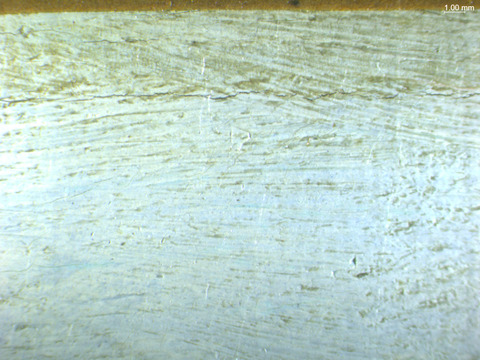
There were visible drying cracks throughout the dark green passages on the left-hand side exposing yellow and light green paint underneath (fig. 5). These cracks visually flattened the area. As noted in the prior condition reports, stress cracks were visible along the entire perimeter of the painting ~0.5 cm from the turnover edge, as well as a crack in the paint layer at the top-right corner running 19 cm from the left edge and 21 cm from the bottom edge. Retouching covered small losses along this damage (fig. 6). This can also be seen in the MA-XRF scan for titanium, along with areas of retouching on three corners of the painting (fig. 7). Both the drying and age cracks appeared to be stable, aside from the bottom-left corner where there was a small area of lifting paint that was abraded at the edges (fig. 8).



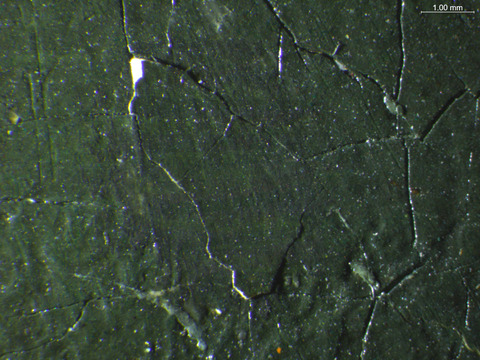
Embedded in the paint layer were canvas fibers and transparent yellow accretions that had caused cracking, likely a result of the lining process (figs. 9, 10, 12). There were small losses to the paint and ground layer on the left-hand side of the painting, close to the turnover edge, and a loss in the “P” of the signature (fig. 11). For these reasons, it was recommended that Landscape undergo conservation treatment in the fall of 2021.10
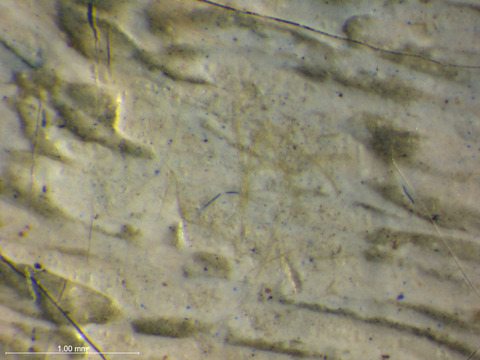
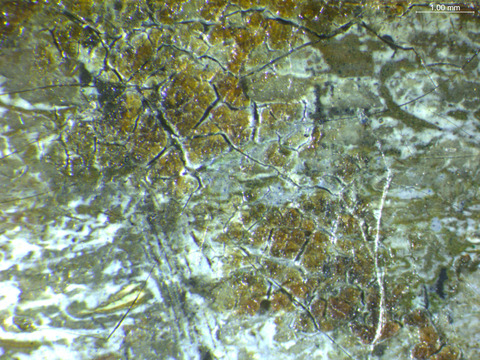
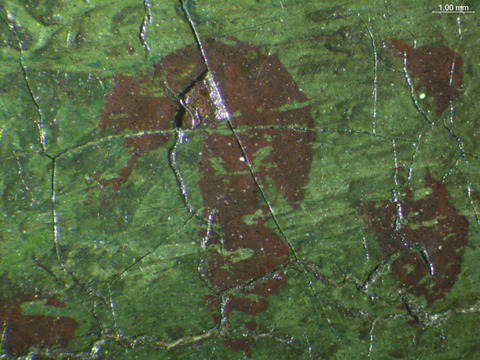
Current Condition Summary
The conservation treatment was completed in May 2022. The painting remains in structurally stable condition. Once cleaned and revarnished, the overall effect is a brighter, more vibrant color palette. The painting appears to have more depth. The sky now recedes into the background, and the brushstrokes that were once tangled with the leaves of the tree on the right-hand side have been softened, making the branches more delineated. The volume of the tree on the left has been returned by inpainting the drying cracks.
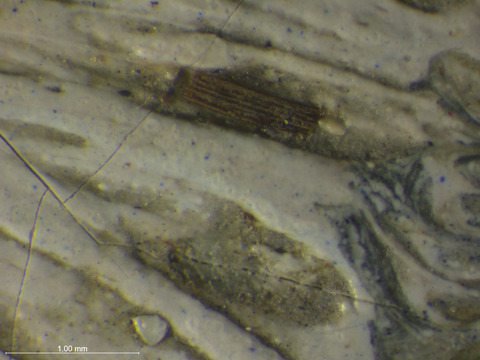
Methods of Examination and Imaging
| Examination/Imaging | Analysis (no sample required) | Analysis (sample required) |
|---|---|---|
| Unaided eye | Dendrochronology | Microchemical analysis |
| Optical microscopy | Wood identification | Fiber ID |
| Incident light | Microchemical analysis | Cross-section sampling |
| Raking light | Thread count analysis | Dispersed pigment sample |
| Reflected/specular light | X-ray fluorescence spectroscopy (XRF) | Fourier-transform infrared spectroscopy (FTIR) |
| Transmitted light | Macro X-ray fluorescence scanning (MA-XRF) | Raman microspectroscopy |
| Ultraviolet-induced visible fluorescence (UV) | ||
| Infrared reflectography (IRR) | Gas chromatography–mass spectrometry (GC-MS) | |
| Infrared transmittography (IRT) | Scanning electron microscope -energy dispersive X-ray spectroscopy (SEM-EDS) | |
| Infrared luminescence | Other: | |
| X-radiography |
Technical Examination
Description of Support
The work is painted on a linen canvas (untested) with a 14 × 13 per cm thread count.11 It has been lined with a similar weight canvas with a 14 × 14 thread count. The painting is likely a number 8 Marine format (46 × 29.7 cm), a standardized size of canvas offered by suppliers in Britain and France in the 19th century.12 As was noted above, the tacking margins have been removed. This may be why the canvas is 2 cm smaller in width and 1.1 cm smaller in length than the standard number 8 Marine canvas. Camille’s use of the Marine canvas, which is very long and narrow in height, is influenced by his mentor Corot, who preferred this format for his landscapes.13
Auxiliary Support:
Original Not original Not able to discern None
The painting is mounted onto a five-member wooden stretcher with mortise and tenon joins at the vertical center member and each corner. All 10 stretcher keys are present but are not secured to the stretcher bars.
Attachment to Auxiliary Support:
Seventy-five evenly spaced tacks penetrate the lining canvas, affixing the painting to the stretcher.
Condition of Support
The support is stable and in plane. On the back, splits have formed in the paper tape at the joints.
Description of Ground
Color:
White
Application:
The painting is prepared with a double ground. The two layers can be seen in the backscattered image of Sample b, a microscopic cross section taken from the green foreground on the bottom left of the painting (fig. 13, 14).
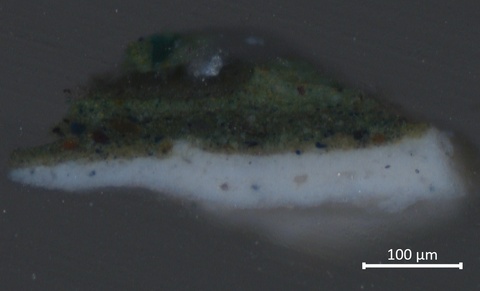
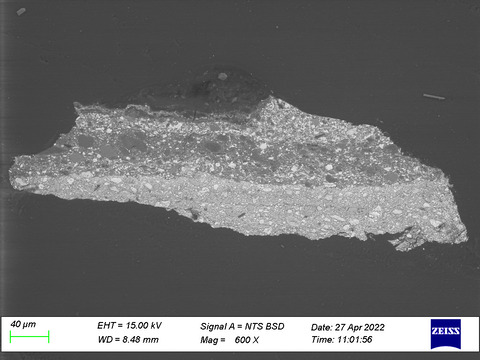
Materials/Binding Medium:
SEM-EDS scans of Sample b detected the presence of lead and barium in both layers of ground (figs. 15, 16). This is indicative of a lead white paint having been used for the priming layers, containing barium sulphate as an extender. This inert material was sometimes added to commercially produced priming layers.14

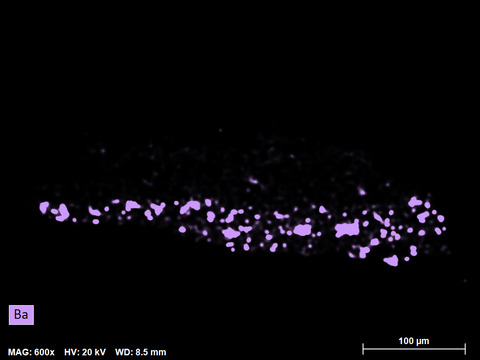
Thickness:
Both ground layers are about 30 micrometers thick. Together, they are about the same thickness as each of the paint layers above. Because the tacking margins have been removed, it is difficult to determine whether the priming layers have been applied by the artist or his colourman.
Character and Appearance (Does texture of support remain detectable/prominent?):
The texture of the canvas weave has been filled by the ground and paint layers. The brushstrokes are readily visible, which is the result of the artist having used paint with a thick texture and stiff brushes. There has been some weave emphasis from the past lining treatment. This can be seen in the raking light photography (fig. 17).
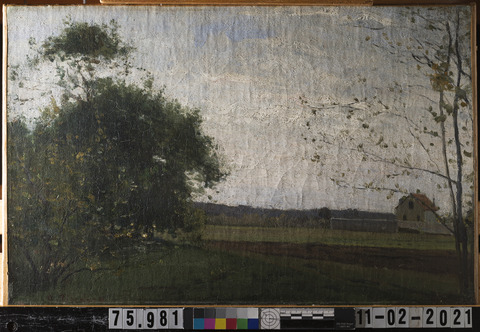
Sizing:
Likely gelatin (untested)
Condition of Ground
The ground layer is well bound and shows no signs of delamination from the canvas or paint layers above.
Description of Composition Planning
Methods of Analysis:
Surface observation (unaided or with magnification)
Infrared reflectography (IRR)
X-radiography
Analysis Parameters:
| X-Ray equipment | GE Inspection Technologies Type: ERESCO 200MFR 3.1, Tube S/N: MIR 201E 58-2812, EN 12543: 1.0mm, Filter: 0.8mm Be + 2mm Al |
|---|---|
| KV: | 25 |
| mA: | 3.0 |
| Exposure time (s) | 120 |
| Distance from x-ray tube: | 36 |
| IRR equipment and wavelength | Modified Nikon D610 camera with a Coastal Optics lens and X-nite 1000C filter |
Medium/Technique:
There is no underdrawing visible in the IR photograph. The X-radiograph does, however, show how Camille planned the composition of his landscapes (fig. 18). Camille blocked out the major elements of the landscape with thin, flat, swaths of color in discrete areas. Where there is a thinner application of paint between each element, the X-rays have passed through, leaving dark borders in the resulting image. He left a reserve for the trees on the left side, but the tree on the right was added after the rest of the composition was blocked in. As Pissarro painted, he adjusted the composition directly on the canvas.
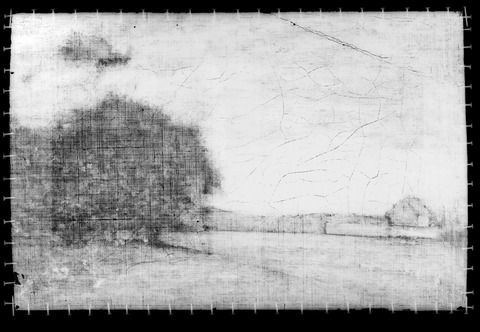
Description of Paint
Analyzed Observed
Application and Technique:
Pissarro built up the foreground and trees at the same time: the cool blue-brown paint used for the tree trunks on the lower right-hand side has been dragged through the wet green paint of the grass (fig. 19). Pissarro then painted in the cloudy sky with wavy horizontal brushstrokes, covering over some of the branches of the tree on the right, wet-over-dry. He then added more branches into the wet paint of the sky. Some branches can still be seen peeking out from underneath the blue brushstrokes of the sky (fig. 20). The leaves were then dabbed into the wet paint.


Painting Tools:
The oil paint was applied with fairly stiff brushes of varying sizes. The imprint of the bristles can be seen in the sky and the dabs of paint making up the leaves (fig. 21).

Binding Media:
Oil paint (untested)
Color Palette:
The detection of chromium in areas of green foliage and grass with the use of MA-XRF scanning suggests the use of viridian (fig. 22). The jewel-like viridian pigment particles can be seen with surface microscopy (fig. 23). Pissarro also used this same pigment in The Banks of the Oise near Pontoise, for the tops of the trees on the left-hand side.

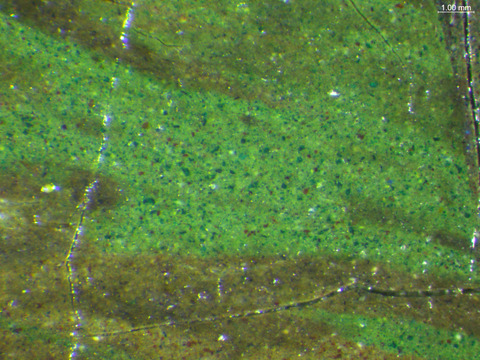
From the cross section of Sample b, is it evident that the green for the foreground is made up of a more complex mixture than simply viridian. For the first layer of paint, just above the ground, yellow and blue are used to make green. SEM-EDS detected iron and silicon in the yellow particles which indicates the primary yellow pigment used is yellow ochre (fig. 24). Detection of cadmium in the brighter yellow particles indicates the use of cadmium yellow as well (fig. 25). Detection of cobalt in the SEM-EDS analysis of the cross section indicates that the blue pigment is cobalt blue (fig. 26).
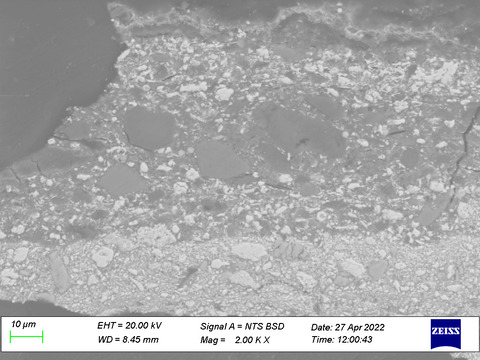
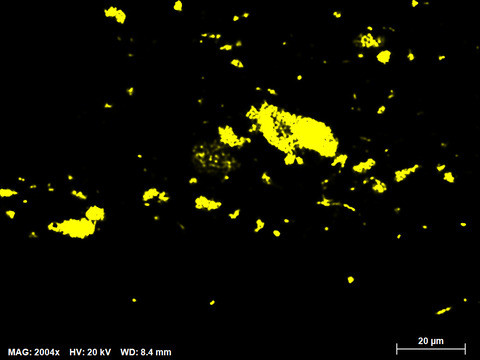


The second layer contains the same mixture, with the addition of red and black pigments. One red pigment particle is likely a red iron oxide, as high iron was localized to this particle in the SEM-EDS scan. Using ultraviolent-induced visible fluorescence imaging, some particles in this layer fluoresce faintly orange-pink (fig. 27). This is characteristic of red madder lake. In the visible light image of the cross section, the particles appear to have faded completely (fig. 28). Aluminum was detected in these particles with SEM-EDS, which is indicative of the substrate onto which red lake pigments would have been precipitated, namely alum. This transparent pigment had been used since the fourteenth century for its qualities as a glaze that could add depth to dark passages like shadows. In the late 19th century, Impressionist artists would continue to use it, but instead of exploiting its transparency, it was mixed with white which would result in a lighter, matte appearance. 15 It is seen consistently in paintings by Camille in the IMA collection as well as in other collections.16 Also in this layer is a black pigment, which is likely bone black as SEM-EDS detected both calcium and phosphorus. The third and final layer contains cadmium yellow and viridian.

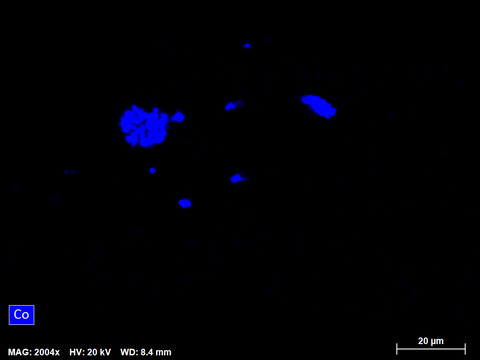
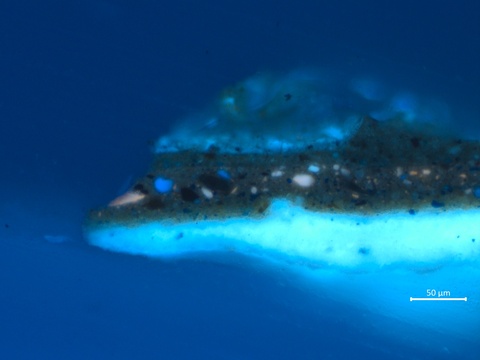
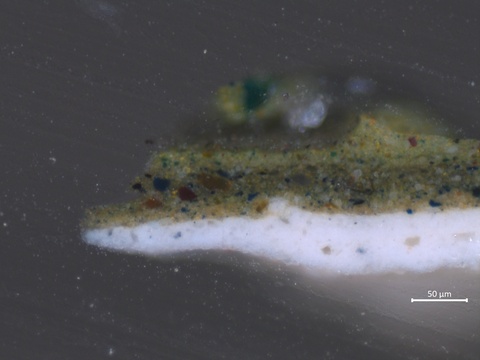
The MA-XRF scan suggests most passages in the painting, aside from the sky, were painted using mixtures containing iron oxides (fig. 29). Both iron and manganese detected with MA-XRF in the tree on the left is indicative of the use of umber (fig. 30). Cobalt in the trunks of the trees in the foreground, as well as the hills in the background at the horizon line, suggests the use of cobalt blue (fig. 31). Cobalt is also present in the sky, along with lead (fig. 32), which indicates the paint is a mixture of cobalt blue and lead white.
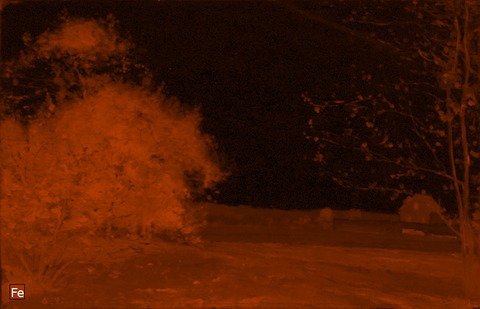
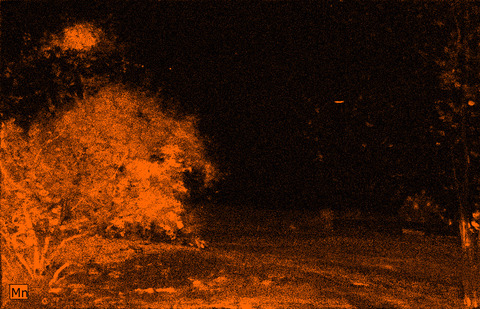
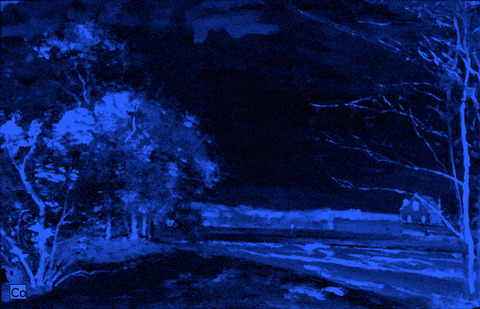
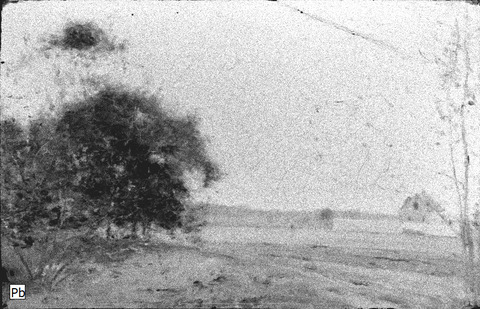
Condition of Paint
Age cracks are present throughout the painting, most apparent in the sky, close to the horizon line. As described in the Summary of Treatment History section, drying cracks were observed in the tree on the left-hand side that have now been inpainted. These drying cracks were caused by the method of paint application. As mentioned in the Description of Ground section under Character and Appearance, the lining process has likely caused the flattening of impasto and weave emphasis that is visible throughout the entire painting (figs. 17, 33).

Description of Varnish/Surface Coating
The painting has a synthetic varnish of 20% Laropal A8117 on the surface, applied with a brush. Although Impressionists later in the century preferred a matte unvarnished surface, in this period of Camille Pissarro’s career from the 1860s to the late 1870s, varnishes were still often applied to saturate the colors of the painting. Camille himself recommended the use of a clear varnish in a letter to his colorman in 1878. Camille wrote, "I am going to recommend to the colorman that he varnish your painting only with a varnish that is uncolored."18
Analyzed Observed Documented
| Type of Varnish | Application |
|---|---|
| Natural resin | Spray applied |
| Synthetic resin/other | Brush applied |
| Multiple Layers observed | Undetermined |
| No coating detected |
Condition of Varnish/Surface Coating
The vanish was applied in 2022 and remains glossy. During the treatment, inpainting was undertaken on the losses, as well as some of the craquelure and discolorations. This can be seen in the ultraviolet-induced fluorescence image below (fig. 34).

Description of Frame
Original/first frame
Period frame
Authenticity cannot be determined at this time/ further art historical research necessary
Reproduction frame (fabricated in the style of)
Replica frame (copy of an existing period frame)
Modern frame

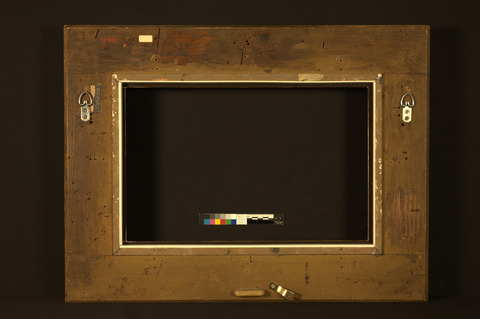
Frame Dimensions:
Outside dimensions: 50.2 × 65.4 cm
Rebate dimensions: unknown
Sight size dimensions: unknown
Distinguishing Marks:
Paper label on the back of the frame, left side rail: “HAYES STORAGE, Inc./ FIREPROOF WAREHOUSE EXPERT PACKERS OF ART/ 305 EAST 61st ST NEW YORK, N.Y.”
Label has blue- or black-inked background, lettering is off-white. Condition of the label is fair due to significant skinning of paper support at the lower half resulting in loss.

Description of Molding/Profile
The primary gilded French Regency style frame has a secondary slip frame at the sight edge. The slip has a flat slanted profile and is water gilded with a slightly rubbed finish over red ground and visible lay lines. The primary frame profile has an ovolo back edge, astragal, and scotia. A gadrooned front edge with acanthus leaf corners borders a shallow ogee with reposes. Ornamented acanthus corners are held on a crosshatched ground by interlacing foliate scrolls with flowers. The corner ornament extends across a sanded frieze and onto a sight edge of linked scrolls with alternating flower and bud. On the top and bottom rails there are crosshatched center cartouches with interlacing foliate scrolls and flowers. The joinery for the primary frame is at a 45-degree miter, the back has applied battens with a beveled edge attached with flat-head nails. Further examination is necessary to determine if the batten joinery is a lap or a mortise and tenon configuration.
Condition of Frame
The frame is structurally secure and in very good aesthetic condition.
Notes
-
In the catalogue raisoné, the painting (number 87) is dated about 1864. According to the authors, “Ludovic-Rodo Pissarro knew of this painting, which is mentioned in the documents for the supplement to the catalogue raisonné of his father's works.” See J. Pissarro and C. Durand-Ruel Snollaerts, Pissarro: Critical Catalogue of Paintings (Milan: Skira; Paris: Wildenstein Institute, 2005), 3:85. ↩︎
-
John Rewald, The History of Impressionism (New York: The Museum of Modern Art, 1973), 94. ↩︎
-
John Rewald, Camille Pissarro, (New York: Harry N. Abrams, 1963), 15. ↩︎
-
D. Bomford et al., Art in the Making: Impressionism (London: National Gallery in association with Yale University Press, 1991), 211. ↩︎
-
Poly(isobutyl methacrylate) or p(iBMA) confirmed with PY-GCMS. ↩︎
-
Ethyl methacrylate and methyl acrylate copolymer p(EMA/MA) confirmed with PY-GCMS. ↩︎
-
Martin Radecki, Conservation Report, 3 March 1976, Conservation Department Files, Indianapolis Museum of Art at Newfields. ↩︎
-
David Miller, “Work Request Form,” 9 September 1982, Conservation Department Files, Indianapolis Museum of Art at Newfields. ↩︎
-
David Miller, “Indianapolis Museum of Art Loan Assessment,” 9 June 2004, Conservation Department Files, Indianapolis Museum of Art at Newfields. ↩︎
-
Alex Chipkin, “Conservation Examination Report & Treatment Proposal,” 14 December 2021, Conservation Department Files, Indianapolis Museum of Art at Newfields. ↩︎
-
D.H. Johnson, “Thread Count Report: Landscape Camille Pissarro 1865 (P87/75.981) from the Indianapolis Museum of Art,” 2021, Conservation Department Files, Indianapolis Museum of Art at Newfields. ↩︎
-
See Lefranc’s “Table of Standardized Canvas Formats” reproduced in A. Callen, Techniques of the Impressionists (London: Chartwell Books, 1993), 59. ↩︎
-
D. Bomford et al., Art in the Making: Impressionism (London: National Gallery in association with Yale University Press, 1991), 29–23. ↩︎
-
D. Bomford et al., Art in the Making: Impressionism (London: National Gallery in association with Yale University Press, 1991), 211. ↩︎
-
"Chapter Eleven: The Colour of Modernity." In The Art of Impressionism: Painting Technique and the Making of Modernity, by Anthea Callen. New Haven: Yale University Press, 2000. Accessed November 16, 2022. https://www-aaeportal-com.ezp-prod1.hul.harvard.edu/?id=-16650#A-16650_63. ↩︎
-
See “Table 2 Pigments Identified” in L. Gutierrez and A. Burnstock, “Technical Examination of Works by Camille and Lucien Pissarro from the Courtauld Gallery,” ArtMatters 5 (2013): 14, https://www.amjournal.org/_files/ugd/14a82d_1cd5fda55c9d4cdbb5cf6168377f1fd2.pdf. ↩︎
-
Low molecular weight urea-aldehyde resin ↩︎
-
Letter from Camille Pissarro to Eugene Murer, 1878, in Correspondance de Camile Pissarro, ed. Janine Bailly-Merzberg (Paris: Presses universitaires de France, 1980), 1:110, as quoted in Michael Swicklik, “French Painting and the Use of Varnish, 1750–1900,” Conservation Research, Studies in the History of Art 41 (1993): 167. ↩︎
Additional Images

